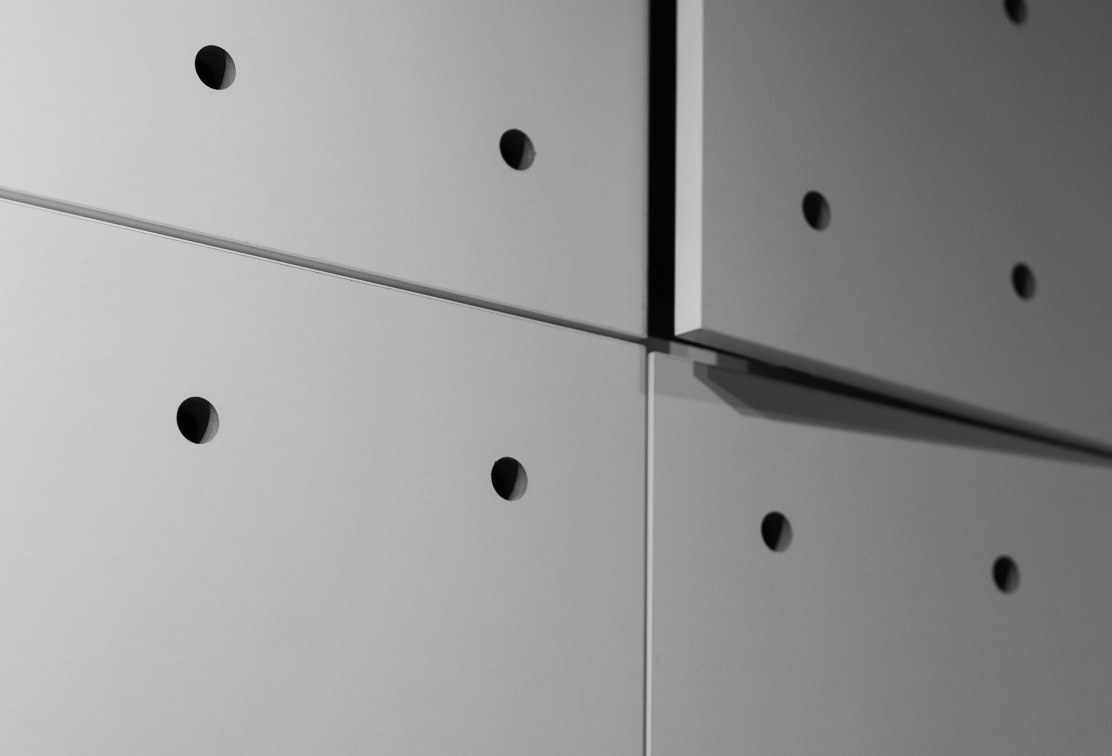
If you’ve ever found yourself marveling over how great a room sounds, chances are, it didn’t sound that great by accident. It was designed that way. Rooms where large crowds gather, performances are held, or loud work gets done require acoustical treatments to handle all those sound waves.
You’ve got a range of options when acoustically treating a room, from acoustical panels to ceiling clouds to microperforations in the interior facade itself. In the case of soundproofing, your options grow even more.
Depending on the budget you’re working with, you’ll want to utilize dense materials and decoupling techniques to prevent vibrations from transferring from one surface to another. Your choices depend primarily on the room you are treating and the amount of sound control needed. One solution that works great in medium to large sized rooms for both acoustical treatment and soundproofing is micro perforated acoustic panels and veneers.
What are microperforations?
You may have heard the term before, but it isn’t common in everyday conversation, so you may not be terribly familiar. That’s okay. Once you understand the concept, it’s easy to see how microperforated surfaces contribute to a superior sound profile.
First, let’s define perforated. Something that is perforated has holes pierced through it. When we used perforated notebooks in school, the paper had tiny holes pierced through it in a line near the edge. This made it easy to get a clean tear when removing individual sheets. It’s a simple concept with tremendous benefits.
A microperforation is simply a very small hole. The layout of the holes doesn’t matter. Something can be perforated in lines, in a pattern, or in a random scattering. When we use microperforations in architecture, the holes allow sound waves to pass into an otherwise reflective material, becoming trapped, which improves the acoustical profile of the room.
The perforations are so small, usually .5-2mm in diameter, most people won’t even notice them until they are within a foot or two of the surface. From any normal viewing distance, they are virtually invisible. This makes perforated timber panels a great solution when you need a clean, upscale look that keeps people comfortable and allows for clear communication.
How microperforations improve acoustics
When we think of acoustical materials, we usually think of fibrous materials like foam that absorb sound waves and transform that sound energy into heat energy—the kind we see in music studios and movie theaters. The fibers vibrate, and the waves are transformed into very small amounts of heat. So, how does a microperf acoustic panel absorb sounds since it looks little like what we expect out of acoustical materials?
Microperforations as acoustical treatments
Porous furnishings like furniture and curtains with soft, fabric upholstery can help a bit. If you’ve got a small to medium sized room, fabric wrapped acoustical panels are an excellent solution. But, if you’ve got a fairly large conference room or concert hall, you’ll need something that can be applied on a much larger scale if you want to adequately tackle your acoustic issues.
Microperforations allow you to transform traditionally solid sound reflectors into porous materials. They are a great option since they perform well in sound absorption, but they don’t present the same drawbacks as conventional porous materials do. You can wipe them down, they are resistant to impact and fire, and they look great to boot.
Another benefit is that they can be used to finish both walls and ceilings. That means you can use the same material on both or mix and match materials for creative results. Microperforated materials range from perforated wood veneer to metal to vinyl so that you can use them in nearly any design aesthetic. They can be used on their own to deliver good, all-around sound absorption and can be backed with acoustical materials if you need a little more sound control.
On the downside, perforated wood acoustic panels can get a little spendy due to the high quality of materials used, so they may not be suitable for smaller rooms that don’t need a whole lot of sound control or when you are working with a very limited budget. For smaller rooms that require minor absorption, you can usually achieve great results by using fabric covered acoustical panels and heavy acoustical curtains.
Microperforations for soundproofing
Part of properly soundproofing a room is introducing sound absorbing materials into the room itself. Since most rooms are made up of hard, reflective surfaces, reverberation causes sound waves to bounce around the room, amplifying as they go. When you are dealing with a louder room, it takes more effort to keep those sounds from traveling. If you want to keep sound out of the next space or property, it’s key to reduce the amount of sound you are trying to contain. Microperforated wall and ceiling materials are the first lines of defense.
Perforated wood panels won’t absorb sounds in all frequencies, however. If the room is regularly subjected to very low bass tones, you will still need to install high density materials that add mass to your walls if you want to achieve superior soundproofing. Common means of achieving this is to roll mass loaded vinyl onto the drywall or add a second layer of drywall on top of the existing drywall, with a layer of green glue between the two.
Depending on the materials used in the construction of the building, you will also likely need to utilize decoupling materials. Loud sounds can cause waves that transfer from one surface to the next, sending vibrations into the structure itself. Decoupling materials stops the transfer of sound energy by absorbing and transforming them before reaching the interior structure. It’s an essential part of wall soundproofing.
Why we soundproof spaces
If you’re considering getting into a soundproofing project, there’s probably a good reason for it. Maybe you own a popular bar in a residential neighborhood and don’t want your business bothering the neighbors. Maybe you want to create a quiet space for confidential conversations with clients. Or, perhaps you just want to watch late night movies without waking your light sleeping spouse. Soundproof spaces offer privacy and allow you to do the things you love without disrupting others.
When we add acoustical treatments and soundproofing materials to spaces, we also do something good for our mental and physical health. Extensive studies have shown that regular exposure to loud sounds can damage the nerve endings in our inner ears and can cause hearing damage and loss. The result is difficulty hearing music and speech correctly and can lead to tinnitus, which is a ringing in the ears that can be disruptive to sleep and concentration.
Speaking of concentration, that’s another place where acoustical treatments and soundproofing are a godsend. When we are subjected to unwanted noise for extended periods, it can be much more difficult to concentrate, and we experience increased stress levels. This can lead to mental fatigue, errors, and all the physical embodiments of stress that wreak havoc on our lives. Reduce stress in your life by reducing unwanted noise.
Finish the room right
There are lots of ways to make a space sound better. Perforated acoustic tiles finish a room right. Most soundproofing materials will disappear into the walls, but the acoustical treatment portion of the equation will be visible to everyone. Why not make them as attractive as possible?
Finishing your room’s interior facade with materials like wood, metal, and vinyl takes your interior design to the next level. Adding microperforations to those materials takes your acoustic profile to the next level. Whether you’re looking for high end wall or ceiling soundproofing materials, take a look at the ever expanding, beautiful selection of microperforated materials to give your space a look and sound you can be proud of.




